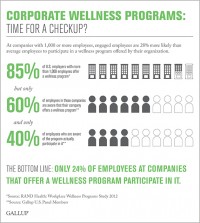Transparency is extremely important to us, so we are letting you know that we may receive a commission on some of links you click on from this page. See our disclaimer.
 “These days, doctors aren't the only ones interested in well-being. Banks, pharmacies, grocers, and other businesses are introducing programs designed to enhance their customers' wellness. But of all the places you go each day, your workplace may have the greatest influence on your well-being. And the person who can best help you achieve results is someone you probably least expect: your manager,” according to Gallup Business Journal.
“These days, doctors aren't the only ones interested in well-being. Banks, pharmacies, grocers, and other businesses are introducing programs designed to enhance their customers' wellness. But of all the places you go each day, your workplace may have the greatest influence on your well-being. And the person who can best help you achieve results is someone you probably least expect: your manager,” according to Gallup Business Journal.
“Many employers have hopped aboard the wellness bandwagon in recent years, recognizing that they can play an influential role in helping employees curtail unhealthy behaviors that can lead to costly chronic conditions. A recent RAND Corporation study found that more than 85% of U.S. companies employing 1,000 people or more offer some sort of workplace wellness program. It's safe to assume that these companies genuinely want to help their employees lead healthier lives while seeing a healthier bottom line too. Not only do employers spend a fortune subsidizing employees' healthcare costs, but they also see greater productivity and fewer missed workdays from employees with higher well-being.”
“Yet simply offering a wellness program — no matter how well-intentioned — provides no guarantee of improving employees' well-being. Workers must be aware the program exists and be persuaded to use it — and that's where things get tricky. Though more than 85% of large employers offer a wellness program, Gallup research shows that only 60% of U.S. employees are aware that their company offers a wellness program — and only 40% of those who are aware of the program say they actually participate in it. The upshot is that at companies that offer wellness programs, only 24% of employees are participating. For companies that provide these programs, it might be time for a checkup.”


0 Comments